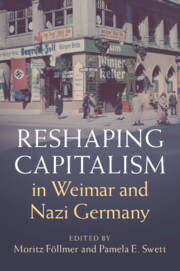Book contents
- Reshaping Capitalism in Weimar and Nazi Germany
- Publications of the German Historical Institute
- Reshaping Capitalism in Weimar and Nazi Germany
- Copyright page
- Contents
- Illustrations
- Contributors
- Acknowledgments
- Introduction Historicizing Capitalism in Germany, 1918–1945
- Part I Debating Capitalism
- Part II Concealing Capitalism
- 4 Capitalism, Wealth, and the Question of (In)Visibility
- 5 Semantics of Success
- 6 Hamburg Coffee Importers
- Part III Promoting Capitalism
- Part IV Racializing Capitalism
- Index
4 - Capitalism, Wealth, and the Question of (In)Visibility
The Thyssen Family and Its Investments
from Part II - Concealing Capitalism
Published online by Cambridge University Press: 20 January 2022
- Reshaping Capitalism in Weimar and Nazi Germany
- Publications of the German Historical Institute
- Reshaping Capitalism in Weimar and Nazi Germany
- Copyright page
- Contents
- Illustrations
- Contributors
- Acknowledgments
- Introduction Historicizing Capitalism in Germany, 1918–1945
- Part I Debating Capitalism
- Part II Concealing Capitalism
- 4 Capitalism, Wealth, and the Question of (In)Visibility
- 5 Semantics of Success
- 6 Hamburg Coffee Importers
- Part III Promoting Capitalism
- Part IV Racializing Capitalism
- Index
Summary
In the 1920s and early 1930s, both the public and scholarly understanding of capitalism was governed by a logic of individual visibility. This angle, however, can easily obscure the fact that invisibility helped shape German society as a capitalist society too. The chapter thus argues that a focus on the interplay of visibility and invisibility can improve our understanding of capitalism in Germany and beyond. By way of example, it analyzes the investment practices of the ultra-wealthy industrialist Thyssen family. It elucidates their opportunities of keeping capital invisible by concentrating public attention to specific family members within the bounds of a nation or Europa, thereby enabling hidden networks of less prominent family members and asset managers to act globally. Although these practices emerged within the specific historical context of the interwar period, they remain relevant today. The chapter thus highlights the long-standing history of exploiting invisibility in capitalist societies.
Keywords
- Type
- Chapter
- Information
- Reshaping Capitalism in Weimar and Nazi Germany , pp. 117 - 135Publisher: Cambridge University PressPrint publication year: 2022



